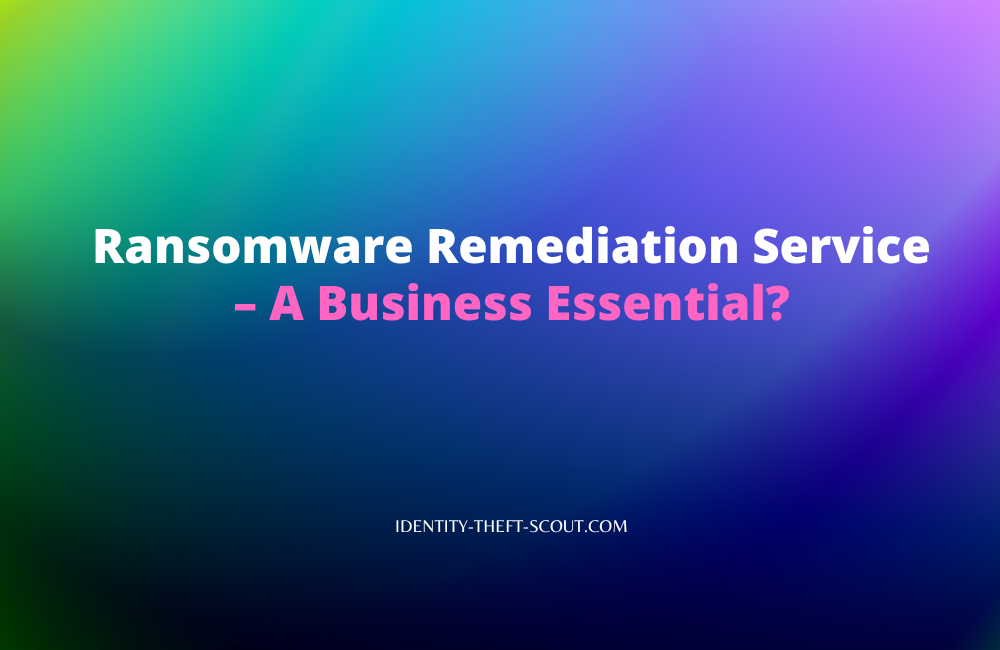
In an article by written by Alexsandar Kochovski for Cloudwards.net revealed some staggering statistics that every Small and Medium Enterprise (SMEs) should be aware of:
“5 Key Ransomware Statistics:
- Ransomware cost the world $20 billion in 2021. That number is expected to rise to $265 billion by 2031.8, 11
- In 2021, 37 percent of all businesses and organizations were hit by ransomware.9
- Recovering from a ransomware attack cost businesses $1.85 million on average in 2021.9
- Out of all ransomware victims, 32 percent pay the ransom, but they only get 65 percent of their data back.9
- Only 57 percent of businesses are successful in recovering their data using a backup.”
A simple Google search will reveal how common ransomware is and the types of search queries, businesses (primarily) are making, here are some examples:
- ransomware recovery consultants
- ransomware help
- ransomware attack
- ransomware removal
- ransomware wiki
- ransomware decryptor
- how to prevent ransomware
- ransomware hackers
- recent ransomware attacks
- ransomware in cyber security
- how does ransomware work
In this article will look at the issue of what ransomware is, how dangerous it is for businesses and what the owners of a business should have in place to protect their business.
1. Ransomware: What is it?
Ransomware is a type of malware that encrypts a victim’s files and demands a ransom be paid to decrypt them. Ransomware attacks have been on the rise in recent years, with small and medium enterprises (SMEs) being particularly vulnerable. This is since SMEs often lack the cyber security infrastructure of larger organizations, making them an easy target for attackers.
Ransomware can have a devastating effect on a business, leading to lost productivity, financial losses, and reputational damage. However, there are steps that SMEs can take to protect themselves from ransomware attacks.
These include implementing strong cyber security measures, backing up data regularly, and having a ransomware remediation plan in place. By taking these precautions, SMEs can reduce their risk of becoming victims of ransomware attacks.
2. Ransomware Statistics
Ransomware has become a major problem for businesses of all sizes in recent years. However, small, and medium-sized enterprises (SMEs) are particularly vulnerable to attacks due to their limited resources and lack of cyber security infrastructure.
The statistics quoted above reveal the significant financial impact that ransomware can have on a business. Not only can an attack result in the loss of data and customer information, but it can also lead to substantial monetary losses. To protect themselves from ransomware attacks, SMEs must invest in strong cyber security measures.
This includes implementing effective backup systems and training employees in best practices for avoiding phishing attacks and other common methods of infection. By taking these steps, SMEs can reduce the risk of becoming victims of ransomware and minimize the potential financial damage of an attack.
3. What Happens to Businesses That are Victims of Ransomware?
Ransomware attacks can have devastating consequences for businesses, resulting in lost productivity, revenue, and even data loss. In some cases, businesses may be forced to pay the ransom to regain access to their data.
However, even if the ransom is paid, there is no guarantee that the attacker will provide the decryption key.
Ransomware recovery can be a complex and costly process, often requiring the help of a professional cyber security firm. In many cases, the best way to protect against ransomware is to maintain regular backups of your data. This way, if your files are encrypted by ransomware, you will still have access to your data.
4. What Happens if You Pay the Ransom
If you are a victim of a ransomware attack, it is important to seek professional help to assess the situation and determine the best course of action. Ransom payments should only be made as a last resort, as there is no guarantee that you will receive your data back or that the attackers will not launch another attack. Ransomware recovery is a complex process, and it is usually best left to the experts.
5. Are There Consultants Who Can Help with Recovery?
Yes, there are cybersecurity consultants that help you with ransomware negotiation and recovery. Few businesses can afford to pay a ransom and not all who do recover their data.
The average cost of a ransomware attack in 2021 was $1.85 million. Many businesses do not have cyber insurance and are unable to recoup these losses. Cyber security consultants specialize in ransomware recovery and often have a higher success rate in data recovery than businesses who attempt to manage the issue on their own.
In addition, cyber security consultants can help businesses to shore up their systems to prevent future attacks. For businesses who have been hit by ransomware, it is important to act quickly and seek out professional help to maximize the chances of recovering data.
6. How Much do Ransomware Recovery Consultants Cost?
Ransomware recovery consultants can help businesses to recover from these attacks and to prevent them from happening in the future. The cost of hiring a ransomware recovery consultant will vary depending on the size and needs of the business, but it is typically a fairly expensive service.
In an article by Carly Page published in Techcrunch.com entitled Ransomware recovery can be costly and not just because of the ransom Carly made this point worth quoting: “Proofpoint says that the remediation process for an average-sized organization takes on average 32,258 hours, which when multiplied by the average $63.50 IT hourly wage totals more than $2 million.
Downtime and lost productivity is another costly consequence of ransomware attacks; the research shows that phishing attacks, for example, which were determined as the root cause of almost one-fifth of ransomware attacks last year, have led to employee productivity losses of $3.2 million in 2021, up from $1.8 million in 2015.”
As such, investing in ransomware recovery services is essential for any business that wants to protect its data.
7. Is it a Crime to Pay the Ransom?
In the United States it is not currently a crime to pay the ransom according to this Federal Bureau Of Investigation Ransomware Fact Sheet, but you are strongly encouraged not to pay it and report the crime in accordance with their instructions so they can track down the criminals.
8. Should You Use a Ransomware Recovery Service?
Yes, because the statistic from documented attacks shows that it is the best strategy to quickly recover the operations of the business and avoid paying the ransom. In addition, Ransomware Recovery Services can provide businesses with the policies, tools, and resources they need to protect themselves from future attacks.
9. How Do Ransomware Recovery Services Work
Ransomware recovery services are companies that help victims of ransomware attacks. These services can help victims recover their files without paying the ransom, restore their systems to a pre-attack state, and protect themselves from future attacks.
There are several different methods that ransomware recovery services use to assist victims. One common method is to utilize backups. If a victim has a backup of their files, they can simply restore their system from the backup and avoid having to pay the ransom.
Another common method is to use decryption tools. Ransomware recovery services may have access to decryption tools that can decrypt the victim’s files without the need for a ransom payment. Finally, some ransomware recovery services may offer direct assistance to victims.
This could involve manually restoring their files or providing victims with resources and advice on how to protect themselves from future attacks.
Ransomware recovery services can be extremely helpful for those who have fallen victim to a ransomware attack. These services can help victims avoid paying the ransom, restore their files, and protect themselves from future attacks. If you have been victimized by ransomware, consider urgently contacting a ransomware recovery service for assistance.
Frequently Asked Questions And Answers
Ransomware is a type of malware that encrypts a victim’s data and demands a ransom payment to decrypt it. Ransomware has become a serious problem for businesses and organizations of all sizes. Here are answers to some frequently asked questions about this growing cyber security threat:
Q1: Is there a ransomware remediation service linked to your cybersecurity service?
A1: Yes. The Bitdefender Ransomware Remediation Service is one service designed to help organizations restore their systems in the event of a ransomware attack. The service includes analysis of the attack, help with data recovery, and guidance on prevention going forward.
In the wake of a ransomware attack, time is of the essence; the sooner an organization can get back up and running, the better. With the Bitdefender Ransomware Remediation Service, organizations can minimize downtime and get back to business as usual as quickly as possible.
For the technically minded here is a You Tube Video of Bitdefender Ransomware Mitigation Use Case Demo:
Q2: How does ransomware work?
A2:Ransomware works by infecting a computer or network and then encrypting the data on the infected devices. The attackers will then demand a ransom payment to provide the decryption key that will allow the victim to regain access to their data.
Ransomware has become a serious problem for businesses and organizations of all sizes, with the average cost of recovering from a ransomware attack reaching $1.85 million in 2021.
Q3: Who is at risk of being attacked by ransomware?
A3: Any individual or organization that uses computers or other devices connected to the internet is at risk of being attacked by ransomware. However, some groups are more likely to be targeted than others, including healthcare organizations, government agencies, and small and medium businesses.
Q4: How can I prevent my business from being attacked by ransomware?
A4: There are several steps that businesses can take to protect themselves from ransomware attacks, including implementing comprehensive cybersecurity measures, educating employees about best practices for avoiding malware, and backing up data regularly. Having a Ransomware Remediation service in place on an ongoing place is an important strategy.
Q5: What should I do if my business is attacked by ransomware?
A5: If your business is attacked by ransomware, the first step is to contact a professional Ransomware Recovery Service who can assess the situation and recommend the best course of action. In some cases, it may be possible to recover your data without paying the ransom.
Q6: How much does it cost to recover from a ransomware attack?
A6: The cost of recovery from a ransomware attack depends on several factors, including the size and scope of the attack, the amount of data encrypted, and whether you have backup copies of your data. In general, however, businesses can expect to spend up to $1 million or more on recovery efforts following a successful attack.
Q7: How long does it take to recover from a ransomware attack?
A7: Again, the answer to this question depends on several factors; however, businesses can typically expect the entire process (from initial infection to full recovery) to take anywhere from two weeks to two months.
Q8: What are the most common types of ransomwares?
A8: There are four main types of ransomwares: CryptoLocker, Locky, Cerber, and CTB-Locker (also known as Critroni). CryptoLocker is the most well-known type of ransomware; however, Locky has emerged as one of the most prevalent threats in recent years due in part to its ability to bypass traditional antivirus solutions.
Q9: How much do attackers typically demand in ransom payments?
A9: The amount demanded in ransom payments varies depending on the type of ransomware used and the size of the target organization; however, attackers typically demand between $500 and $1 million in Bitcoin or other cryptocurrency for decryption keys. In some cases, attackers will also offer discounts for victims who pay within a certain period (usually 24-48 hours).
Q10: Do victims ever get their data back after paying the ransom?
A10: Around 32 percent of victims choose to pay the ransom; however, there is no guarantee that they will receive their decryption key after doing so (in fact, only 65 percent of victims who pay get their data back). Therefore, it is generally not advisable to pay unless you are confident that you will be able to retrieve your data successfully.”
Further Reading:
The following articles provide more information on the dangers of ransomware:
– Ransomware: An evolving threat landscape (Department of Homeland Security)
– Ransomware 101 (National Cybersecurity Alliance)
– Ransomware: The Landscape Is Shifting (Kennesaw State University)
– How Can I Protect Against Ransomware(An official website of the United States Government)
–A Guide to Ransomware (UK National Cyber Security Centre)
– Ransomware – What You Need To Know (Check Point and Europol)


